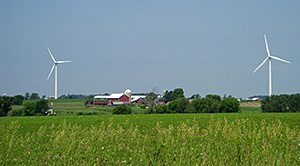Wind Project Site Selection

Careful wind farm or wind turbine siting aims to support responsible wind energy development and eliminate negative impacts to wildlife and local communities.
What Is the Best Location for Wind Turbines?
There are many factors to consider when choosing a location for a wind turbine or wind farm, such as (but not limited to) the wind resource potential in the area, proximity to existing power lines, and potential environmental impacts.
This process of selecting a location for a wind energy project, known as “siting,” includes reviewing wind maps and data, securing permits and following ordinances, and ensuring best practices for the size and proposed location of a project.
A 2022 webinar recording from a U.S. Department of Energy Office of Energy Efficiency and Renewable Energy siting workshop invited state energy officials to learn from each other on siting wind energy and other renewable energy projects.
What Factors Are Considered When Choosing a Wind Farm Location?
The goal of responsible siting is to promote the coexistence of wind energy and local communities by minimizing or eliminating negative impacts to wildlife and people.
Careful siting requires thorough research and thoughtful public engagement. Resources from the following categories aid in the critical project planning step of site selection for a wind turbine or wind farm.
In addition to the below resources, WINDExchange’s resources and tools for selecting wind development sites offer a vast library of research to help with siting decisions.
Maps Identify Windy Areas
Wind energy maps and anemometer data help developers, homeowners, communities, states, and regions make informed decisions about where to develop wind projects. WINDExchange provides resource maps for land-based utility-scale, community-scale, offshore, and residential-scale wind development.
Wind Energy Ordinances and Permitting Regulate Wind Energy Projects
Local governments may create ordinances to regulate wind turbine installations within county or city borders, specifying location, permitting processes, and construction that developers must follow. Details such as noise, safety, and land use can also be included in ordinance regulations. The WINDExchange website offers a database of state and local wind energy ordinances.
Securing necessary permitting and reviews is a legal requirement for all energy projects to ensure compliance with state, federal, and local policies and regulations. Learn about securing necessary permits and reviews and organizations working to address issues related to permitting wind projects.
Wind projects on public lands or in public waters provide lease payments to the state and other relevant jurisdictions in close proximity to the installations. These projects require additional siting and permitting work by developers and regulatory bodies.
Offshore, the U.S. Department of the Interior’s Bureau of Ocean Energy Management helps regulate the locations of wind farms, which includes environmental aspects, other uses for those spaces, and other regulations. In a 2022 webinar, wind energy experts presented a high-level summary of decision-making processes at the federal, state, and local level for offshore wind energy siting and permitting.
Observation Helps Developers Minimize Wildlife Interactions
Researchers observe wildlife behavior and develop predictive models that outline, for example, bird or bat flight patterns. That information can inform developers where they can site their wind farm to minimize potential interaction between wildlife and wind turbines. Learn more about environmental and wildlife aspects of wind energy.
The Public and Local Communities Provide Input
Community wind projects allow local organizations to develop local projects that result in more economic benefits to the community than conventional wind projects developed by companies with limited local ties. The Small Community Wind Handbook and Large Community Wind Handbook, produced by the National Renewable Energy Laboratory, provide siting guidance for developing these types of projects.
The Small Wind Guidebook provides basic information about small wind electric systems, including how to choose the best site for a small wind turbine. The Small Wind Site Assessment Guidelines, produced by researchers at the National Renewable Energy Laboratory, also provides guidance on siting small wind projects.
The WINDExchange siting guide offers a community perspective that decision makers can use as a resource when considering utility-scale, land-based wind energy project development.
The public can also engage with offshore wind energy siting decisions. Watch the Offshore Wind Energy Basics: Navigating Offshore Wind Energy Decision-Making Processes webinar to learn about the points at which community leaders, property owners, coastal residents, and other local stakeholders can meaningfully engage with these processes.